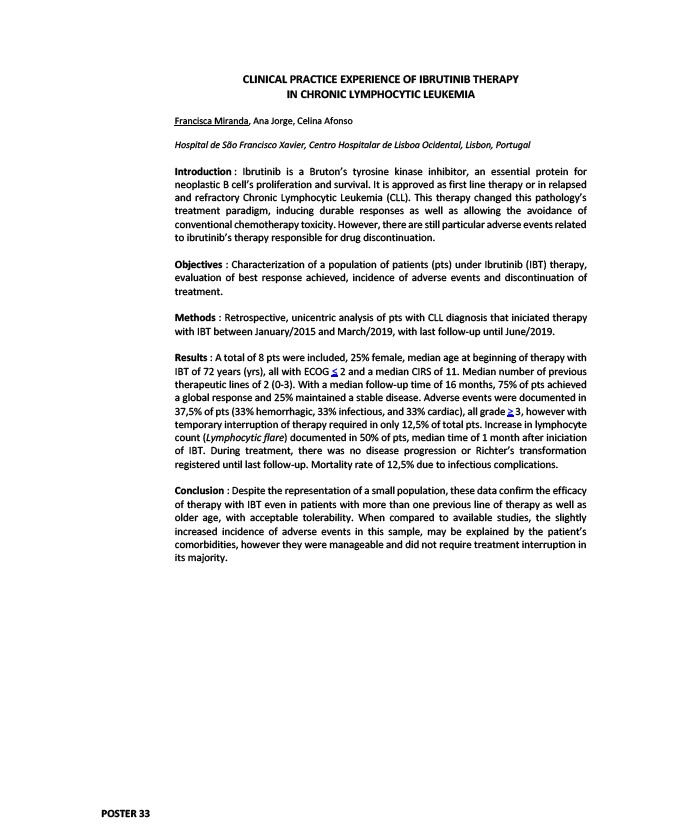
CLINICAL PRACTICE EXPERIENCE OF IBRUTINIB THERAPY
IN CHRONIC LYMPHOCYTIC LEUKEMIA
Francisca Miranda, Ana Jorge, Celina Afonso
Hospital de São Francisco Xavier, Centro Hospitalar de Lisboa Ocidental, Lisbon, Portugal
Introduction : Ibrutinib is a Bruton’s tyrosine kinase inhibitor, an essential protein for
neoplastic B cell’s proliferation and survival. It is approved as first line therapy or in relapsed
and refractory Chronic Lymphocytic Leukemia (CLL). This therapy changed this pathology’s
treatment paradigm, inducing durable responses as well as allowing the avoidance of
conventional chemotherapy toxicity. However, there are still particular adverse events related
to ibrutinib’s therapy responsible for drug discontinuation.
Objectives : Characterization of a population of patients (pts) under Ibrutinib (IBT) therapy,
evaluation of best response achieved, incidence of adverse events and discontinuation of
treatment.
Methods : Retrospective, unicentric analysis of pts with CLL diagnosis that iniciated therapy
with IBT between January/2015 and March/2019, with last follow-up until June/2019.
Results : A total of 8 pts were included, 25% female, median age at beginning of therapy with
IBT of 72 years (yrs), all with ECOG ≤ 2 and a median CIRS of 11. Median number of previous
therapeutic lines of 2 (0-3). With a median follow-up time of 16 months, 75% of pts achieved
a global response and 25% maintained a stable disease. Adverse events were documented in
37,5% of pts (33% hemorrhagic, 33% infectious, and 33% cardiac), all grade ≥ 3, however with
temporary interruption of therapy required in only 12,5% of total pts. Increase in lymphocyte
count (Lymphocytic flare) documented in 50% of pts, median time of 1 month after iniciation
of IBT. During treatment, there was no disease progression or Richter’s transformation
registered until last follow-up. Mortality rate of 12,5% due to infectious complications.
Conclusion : Despite the representation of a small population, these data confirm the efficacy
of therapy with IBT even in patients with more than one previous line of therapy as well as
older age, with acceptable tolerability. When compared to available studies, the slightly
increased incidence of adverse events in this sample, may be explained by the patient’s
comorbidities, however they were manageable and did not require treatment interruption in
its majority.
POSTER 33